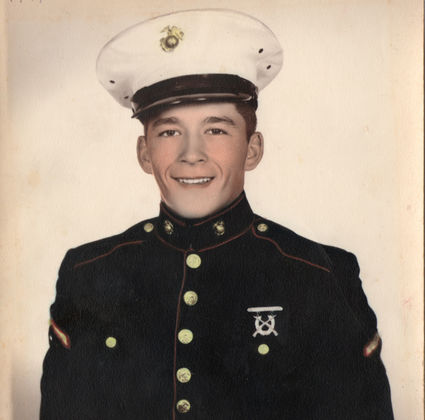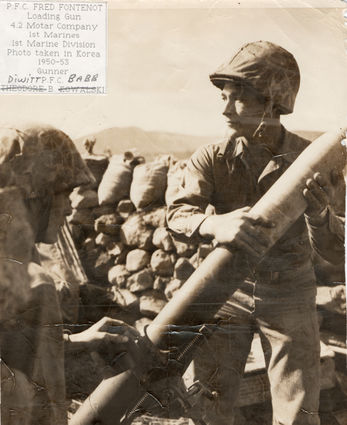Chosin Marine recalls frozen nights, purple heart
Last updated 11/10/2010 at Noon
Editor’s Note: The U.S. Marine Corps is celebrating its 235 anniversary today. The Marine Corp Birthday Ball will be on Saturday, Nov. 13 from 6 p.m. to midnight. The Marine Corp serves along side of the U.S. Navy and each year the Corps has over 2,000 officers that are commissioned and over 38,000 recruits that are accepted and trained. The official motto for the Corp is Semper Fidelis (Semper Fi), meaning “always faithful” and the English Bulldog is their mascot. Most Marines have adopted the phrase “Once a Marine, Always a Marine” and have refused to use the term “ex-Marine.”
Sixty one years after he enlisted, Fred Fontenot still wears his Dress Blues on Sundays and special occasions.
He graduated from Stark High School in 1949 and “I couldn’t find a job so, on July 3, 1949, I enlisted in the Marine Corps [at 17 years of age],” he said. He was then sent to San Diego, Calif. for boot camp and graduated from the Marine Corp Recruiting Depot (MCRD) in Sept. 1949. From there, he went to Wire Communication School at Camp Delmar, across the road from Camp Pendleton in Oceanside, Calif. In May of 1950, he graduated from Wire Communication School and was then shipped out to Camp LeJeune, N.C. While he was preparing to be sent to the Mediterranean, the problems in Korea were escalating and he was shipped back to Camp Pendleton in June.
“At Camp Pendleton, they initiated the First Brigade to go to Korea real quick to help the Army out at Pusan, Korea because they were about to be pushed into the ocean.,” Fontenot said. “My regiment was sent to Kobe, Japan for ten days.” When they set sail for the southern tip of Korea, the ship he was on got caught in a typhoon. “We were dipping water on both sides.”
“On Sept. 15, we made the Inchon Amphibious Landing in Inchon, Korea,” he said. From there his regiment faced combat the all the way up to Seoul. After his regiment captured Seoul, they went back to Inchon only to be shipped to the port of Wonsan. His regiment had to wait ten days aboard ship because the port was mined very heavily.
When Fontenot and the rest of his regiment traveled up near the Chosin Reservoir, 120,000 Chinese soldiers began to surround them. The United Nations troops totaled 30,000, they were out numbered 4:1. They were trapped in the mountains from Nov. 27, 1950 to Dec. 13, 1950. Temperatures ranged from zero degrees to -65 below zero. Not only were troops fighting Chinese fire, but they were also facing extreme frost bite. “My unit was the last unit out, we drug the anchor,” Fontenot said. “In those two weeks, we had 12,000 casualties.” The troops that survived the Battle of Chosin Reservoir call themselves “The Chosin Few.”
On June 14, 1951, Fontenot was with Item Company, 3rd Battalion - 1st Regimen, “we were on a hill. The North Koreans were right across from us,” he said. “Shell were going over head, shells were going back. Come dawn, the planes started dropping napalm. They were so close to us that we could feel the heat from it.
“Everything was going good and I was sitting in my hole reading,” he said. “Something didn’t sound right. All of a sudden, a shell had hit and I jumped up. I was hit.” Fontenot was wounded above the right eye. “It was the best thing that ever happened to me. I was really bleeding out. I called a corpsman over to come patch me up. He bandaged me up and told me to go check out with the first sergeant.
“I got [approximately 30 to 40 feet] from my hole,” he said. “I heard a voice [in my head] that said ‘stop, turn around and look.’ I don’t know where the voice came from, but I did. Just as I turned around, a shell landed in the hole I was in.” Fontenot received the Purple Heart Medal for his injury. “I’m glad that I got it because it saved my life.”
He stayed with the regiment at the hospital for two weeks. He was sent back to his unit and then was sent to San Fransico in July of 1951. When he got back, he was transferred and was offered to go to any Marine camp in the country. Not knowing what he really wanted to do, he asked to be sent back to Camp LeJeune. On Sept. 16, 1951, he reported for duty and was assigned to Base Communications and he installed telephones on base.
About two weeks after he was there, this man named Ray Shaw approached Fontenot and invited him to go to Kinston, N.C. with him. “We went to a little place where the boys went to meet the girls,” he said. “There were about five of us Marines sitting there talking. I looked up and saw three girls come through the door. I said ‘the middle one’s mine.’” He watched her walk to a table where she sat down. Fontenot got up, went over and asked her to dance. “We’ve been dancing ever since,” Fontenot said as he teared up. “That was 59 years ago.”
The rest of his time in the Marine Corps was spent being transferred from one camp to another. “Marines don’t stay in one spot very long,” he said. “We’re out doing some kind of training.”
In September of 1957, his wife, Lois, reminded him that they had been married for six years and didn’t have any children. She also told him that his traveling kept her nervous. He was up for discharge and decided to not re-enlist.
On April 1, 1957, Fontenot was officially discharged. He looked for a job in North Carolina but ended up moving back to Orange because he couldn’t find one. Fontenote built a new house in 1959 and took odd jobs to make ends meet. On Oct. 21, 1960, Fontenot’s 29th birthday, his first son was born. He was still having a hard time finding stable work. He went for a walk in downtown Orange and his luck changed. He met the post master, Al Turner and they walked around for a bit. Turner asked if he had a job and encouraged Fontenot to go take the postal test. On March 26, 1962, Fontenot went to work for the Post Office. “I even quit biting my fingernails,” he said.
He worked for the Post Office for 25 years and given credit for the nine years he spent in the Marine Corps. He retired in 1986 after 34 years of serving his country. “When I retired, the first thing we did was go to Washington state to pick apples,” he said. “We picked apples every year for nine years.”
Fontenot has been extremely active with “The Chosin Few.” Every other year, they have international rallies and it’s always in a different part of the country each time. They also wear their Dress Blues to attend the funerals of fellow Marines that have passed on if the families approve.
Fred and Lois have two sons, one grandson and still live in the original house they built in Orange 51 years ago.
















Reader Comments(0)